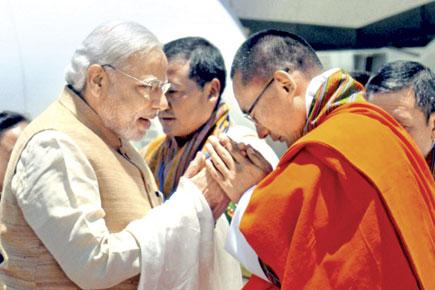With a prayer on my lips: It is a privilege to report on a Prime Minister’s maiden foreign visit and Bhutan is certainly on every Indian journalist’s bucket list

 With a prayer on my lips: It is a privilege to report on a Prime Minister’s maiden foreign visit and Bhutan is certainly on every Indian journalist’s bucket list. But for a queasy flyer, landing at Paro airport is a nightmare.
With a prayer on my lips: It is a privilege to report on a Prime Minister’s maiden foreign visit and Bhutan is certainly on every Indian journalist’s bucket list. But for a queasy flyer, landing at Paro airport is a nightmare.
It doesn’t help that while nervous flyers like me are gripping the seat handles, excited tourists are clicking the sharp peaks visible at an arm’s distance from the plane window. Paro Airport is 1.5 miles above sea level and surrounded by sharp peaks up to 18,000 ft tall.
ADVERTISEMENT

Prime Minister Narendra Modi is received by his Bhutanese counterpart Tshering Tobgay, at the Paro International Airport in Bhutan on Sunday. This is Modi’s first foreign visit as PM. Pic/PTI
There are just ten pilots in the world qualified to fly into Paro and the Druk Air pilot, who has trained in Florida, expertly manoeuvres the aircraft around these peaks. It seems as if he respectfully performs a circumambulation of the mountains, before finding the single point of entry into the landing area and smoothly lands the plane. Phew!
A smile on every lip: The Bhutanese are very happy that the Indian Prime Minister decided to choose their tiny country for his first foreign visit. Most people know quite a lot about Mr Modi. Word travels fast in this remote Himalayan kingdom. “He is the son of a poor man, we know. Just like our Prime Minister.
Do you know our current Prime Minister’s father worked as a labourer on this very road, this Paro to Thimpu road, built with Indian assistance?” Tashi smiles at us as he loads our bags into his Santro cab. That same smile greets us as we check into our hotel. They all smile, even when things don’t work! Salman Khan and Aamir Khan: These two Bollywood icons are found everywhere in the world, they follow you in photographs, in conversations, and in songs played in cabs.
From Kabul to Sharm-el-Sheikh to Copenhagen to Thimpu, almost in every Prime Ministerial visit that I have covered, some local interpreter or cab driver has always asked if I have met one of these two actors. And the hotel where the Indian media team is staying is called Phunstsho Peiri. Doesn’t that sound like a place Phunsukh Wangdu of 3 Idiots played by Aamir Khan would stay in?
Why wouldn’t you come here?: Seriously, why would you not visit Bhutan. You don’t need a visa, your rupee works here; it’s a foreign country and they like you. And they don’t frown even when you behave like the proverbial Ugly Indian Traveller.
Accept it, we are quite obnoxious. Our children run all over restaurants yelling at the top of their lungs, we stare and giggle at people who don’t look or speak like us, we spit and litter. Yet the Bhutanese will not tell us off. There are few places in the world where people are as tolerant as the Bhutanese.
Why are they happy?: This really is an ancient mystery. What makes people happy? How does one gauge the happiness quotient? In case you have been living under a rock and you don’t know, Bhutanese are the happiest people on this planet.
How do they measure happiness? Officially it is this: The concept of Gross National Happiness consists of four pillars: Fair socio-economic development (better education and health), conservation and promotion of a vibrant culture, environmental protection and good governance.
Bhutan has developed 38 sub-indexes, 72 indicators and 151 variables to analyse happiness. It concluded that they are quite happy: in fact, they are the happiest. Here we are dictating their foreign and security policy, building their infrastructure, keeping them safe and secluded, and guess what they are not rebelling.
The Bhutanese actually like being in India’s warm embrace. This is awkward, at least for us journalists. But I vow to come back as a tourist and enjoy this happiness and warmth.
Splendid Isolation: Bhutan’s geo-strategic location makes it very important for its two neighbouring countries, China and India. Bhutan has benefited immensely from aligning with India and keeping China at an arm’s distance.
There is no Chinese embassy in Thimpu and Bhutan has an unsettled land dispute with China. Security imperatives, and historical and cultural links,make Bhutan align with India regardless of the government in power. The country is starting to reach out to the world, but slowly and cautiously.
The land of the Druk: If you are a child of the seventies, you would have grown up on two brands of jams and squashes: Kissan and Druk. The Druk products come from Bhutan. Druk means ‘thunder dragon’ and refers to the ancient name of Bhutan, Druk-yul.
Smita Prakash is Editor, News at Asian News International. You can follow her on twitter @smitaprakash
 Subscribe today by clicking the link and stay updated with the latest news!" Click here!
Subscribe today by clicking the link and stay updated with the latest news!" Click here!







